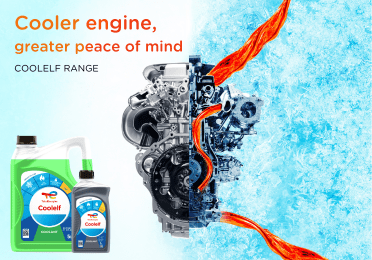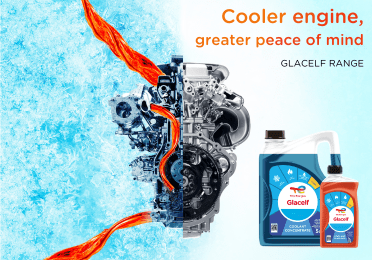What is engine coolant? What does it do?
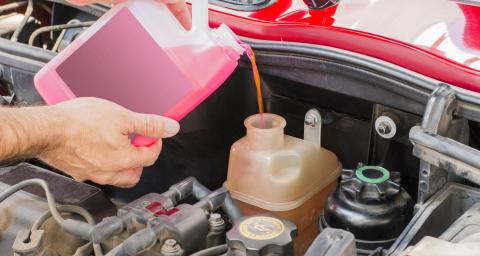
Engine coolant is a mixture of water and antifreeze that keeps the temperature of your engine and its components at a safe level. It does this thanks to having a lower freezing point and higher boiling point than water. The fluid draws away excessive heat from, or heats up, components in the engine by flowing through the cooling system around the engine.
Without coolant, parts can corrode, seize up, and break, so it’s a key ingredient to maintaining your car. On this page, learn more about engine coolant for drivers, including important topics such as how to diagnose issues and use coolant effectively.
TotalEnergies COOLELF
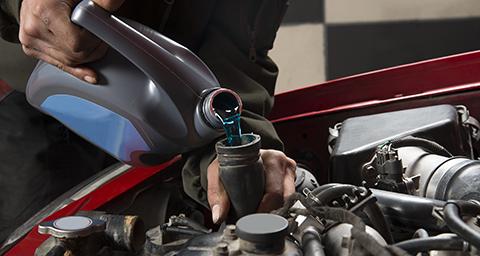
Our COOLELF range of car coolants are specially formulated with OAT inhibitor technology. This improves the performance and lifespan of the coolant; protects the engine from oxidation, deposits, and cavitation; and provides protection down to -37°C. Whatever your make and model, COOLELF protects.
What engine coolant do i need?
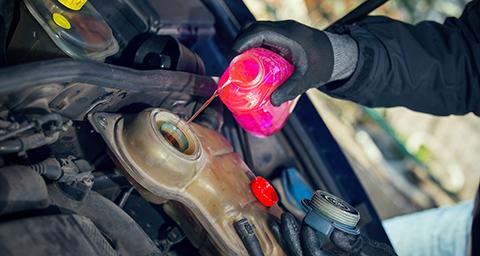
Getting hold of the right engine coolant is important. Using the wrong type can damage your cooling system, leave your engine open to overheating, and affect your engine function as a result. There are many different types of coolant you might need for your vehicle, including green Inorganic Additive Technology (IAT) coolant, orange Organic Acid Technology (OAT) coolant, and pink Phosphated Hybrid OAT (P-HOAT) coolant.
To make sure you are using the correct one, check out our guide to finding out what engine coolant you need.
Getting hold of the right engine coolant is important. Using the wrong type can damage your cooling system, leave your engine open to overheating, and affect your engine function as a result. There are many different types of coolant you might need for your vehicle, including green Inorganic Additive Technology (IAT) coolant, orange Organic Acid Technology (OAT) coolant, and pink Phosphated Hybrid OAT (P-HOAT) coolant.
To make sure you are using the correct one, check out our guide to finding out what engine coolant you need.
How to check engine coolant
It’s important to make sure that your car has an adequate supply of engine coolant flowing around its cooling system.
That’s why it’s important to check your engine coolant level and top it up from time to time as water evaporates from the solution. Additionally, a low coolant level can be caused by a leak, so checking the level should be a regular task in your DIY car maintenance calendar.
Learn how to check and top up your coolant with our handy guide.
Why does my engine coolant keep disappearing?
If you’ve checked your engine coolant and it keeps disappearing as shown by a lowered reservoir level, puddle beneath your car, or an engine coolant dashboard light that becomes illuminated too soon after you’ve topped up, your cooling system could be leaking.
Coolant leaks can occur throughout the system. There may be a crack in one of your coolant hoses, an issue with your water pump, or your radiator may have a perforation that is allowing the coolant to drip away. The reservoir cap or head gasket may also be broken.
Coolant is toxic to people and pets, and a broken cooling system can put your vehicle at risk of breakdowns, so you need to fix the issue, fast. To find, diagnose, and fix a coolant leak, view our guide below.
How much engine coolant do i need?
Your car’s coolant system will typically hold around 5 litres of coolant, though this can differ depending on the make and model. You can find out the exact amount from the handbook or your car dealer.
Engine coolants come in a range of bottle sizes so you should be able to get hold of a pack for a full coolant change or quick top-up - whichever suits the maintenance job to hand.
Can you put water in coolant?
Yes, you can put water in coolant, with some caveats. First, you should only do so in an emergency, such as if you run low on coolant and your car is overheating while on the road. That’s because automotive cooling systems are designed to run on a mixture of 50% antifreeze, 50% water - coolant. If the mixture is off, the performance of the system will be adversely affected.
If you do choose to put water in the cooling system, you should let your car’s engine cool down and make sure to use a cloth to open the reservoir - which may potentially be full of superheated steam. Be sure to pour in the water very carefully too.
You should also only drive your car to your home, and then take it to a garage as soon as possible to have your cooling system looked over for damage and leaks, the water flushed out, and fresh coolant poured back in its place.
It’s also important you use the cleanest water available as well. Distilled is best, however bottled or tap water can be used in absolute emergencies. The more impure the water source, and the longer you keep driving, the more likely that your cooling system will be hampered by mineral deposits.
Can a coolant leak cause a 'check engine' light?
Yes, a coolant leak can cause a ‘check engine’ light (also known as the malfunction illumination light (MIL) to show on your dashboard.
That’s because the cooling system is crucial to the health and performance of your engine. If your coolant level is low, then your engine will either heat up above, or cool down below, its operating temperature, affecting its function. This can cause the ‘check engine’ light to show.
That’s not all though. If the temperature rises too high, the Engine Coolant Temperature (ECT) sensor itself can be damaged. This means that simply adding more coolant won’t solve the MIL problem, as the engine will understand that there is an error with the ECT sensor. As a result, the ECT may also need to be replaced.
This goes to show just how important it is to keep your cooling system topped up with coolant while on the road.
How often should engine coolant be changed?
While the exact timing depends on the make and model of the vehicle, engine coolant typically needs to be changed between two years or 30,000 miles for silicate coolants - whichever comes sooner - or five years or 100,000 miles for coolants designed with specially extended drain intervals.
Coolant needs to be changed because, over time, its composition will change and the ingredients within it will deteriorate. Old coolant won’t protect the engine from overheating as well as new fluid, and other features like corrosion prevention can also be lost over time, putting the cooling system at risk.
To find out the specific coolant drainage interval for your car, check your owner’s manual or talk to your mechanic.
Why is my engine coolant brown?
If you check your engine coolant and it is brown and/or bubbling, then it’s likely your cooling system is suffering from rust formation and accumulation. Combustion gases may also be finding their way into the cooling system via the vehicle’s cylinders due to a blown or broken head gasket.
If you encounter either of these issues, you should visit a mechanic. They will drain your coolant, then assess the system and other engine components for damage. It’s important you don’t continue to drive the vehicle, as even more extensive (and expensive) damage can be done to the cooling system and wider engine if the coolant is brown or bubbling.
Keep your engine cool and running efficiently with
TotalEnergies COOLELF
Run your cooling system with TotalEnergies COOLELF. It protects components while guarding against overheating, reducing your maintenance costs, and resulting in fewer headaches while out on the road.



